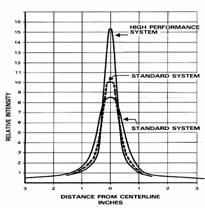Guide to UV Measurement
Peak Irradiance
Peak irradiance is the highest power level of radiant energy at the work surface. Typical irradiance profiles are illustrated in Figure 2. All three lamps illustrated in Figure 2 deliver the same total energy to a surface passing under them, but at different irradiance levels (note that the area under each curve is the same but the peak is very different). These bulbs have the same electrical power input ("watts per cm") but are of different diameters, the smallest yielding the highest peak. The elliptical reflector is generally the highest efficiency of reflector, as it has the greatest "wrap," or included angle of reflected energy about the bulb. Often reflector shapes other than the simple ellipse are considered. Table I shows the relative merits, measured by speed to achieve cure of a black screen ink. This demonstrates the effects of bulb diameter and reflector geometry with lamps of the same power, but different peak irradiance and optical efficiency. |
|
Lamp Diameter Reflector Type (120 w/cm) |
Cure Speed (m/min) |
Energy (mJ/cm2) |
"Index of Effectiveness" Speed/Energy |
9 mm, elliptical |
21.2 |
140 |
151 |
23 mm, elliptical |
13.6 |
200 |
68 |
23 mm, parabolic |
12.1 |
190 |
64 |
Black screen ink on polycarbonate, 390 mesh |
|||
Controlling maximum peak irradiance is principally through the selection of lamp geometry, because it is integrally associated with reflector design and bulb diameter . Reflector shape (e.g., elliptical or parabolic), reflectivity and precision of shape, bulb diameter, radiant efficiency, electrical power input will contribute to peak irradiance at any distance from the lamp.
